Many enterprises are adopting SD-WAN for their networks, as it provides superior performance in a cloud-centric environment. Many of the conventional WAN solutions were good when applications tended to be in a centralized location. For example, companies would have a mainframe, which would mean the wide-area network solutions would connect to this central location. However, that’s no longer the case, so companies now adopt software-defined wide-area networks (SD-WAN) solutions to make traffic management, access, and other aspects of the networking solution easier.
To better understand why your company might benefit from an SD-WAN solution, let’s first see what this technology is and five reasons why enterprises choose it over other solutions!
What Is SD-WAN?
As noted in the introduction, SD-WAN stands for software-defined wide-area network.
A traditional wide-area network typically consists of leased telecommunications circuits. They connect business, school, and government entities. For example, a school district might use a WAN to connect the schools with the district’s head office IT department. From there, the staff can deploy applications, updates, and other things over a secure connection.
While this approach has historically worked well, the cloud disrupts it. Instead of having a central place from which you push application updates, most apps now run in the cloud. A school, for example, would access and get SharePoint on the cloud, not from a central server in the district’s head office. However, schools still likely need some form of secure connectivity to each other.
A traditional WAN typically uses MPLS (multi-protocol label switching) to provide efficient packet routing. However, the problem is that these routes “need to be painstakingly provisioned,” and making changes is not easy. You typically need to make these routes at the hardware level.
With SD-WAN technology, you can define your WAN via software and provide all the SD-WAN policies from a central location. Everything becomes much more streamlined. Instead of multiple places having different routing tables, you can modify your WAN policies without leaving the office.
What Are the Benefits of SD-WAN?
SD-WAN has received a substantial amount of hype in the past few years. Here are the top five benefits of SD-WAN and why you might want to consider it for your networking solution!
1) Less Expensive Than Pure MPLS
MPLS traffic is not likely to die entirely. MPLS provides guarantees for real-time applications (e.g., video conferencing applications). However, the connection to your Office 365 applications on the internet doesn’t need to go through MPLS, requiring you to have a more significant connection between offices. This traffic can go through the internet.
With software-defined solutions, you can also constantly tweak your configurations to find the best ones for your company. You might find that employees can access certain file shares over an internet connection because that doesn’t need to be real-time, but employees need reliable, real-time access to other ones. These are the types of rules that you can, in theory, define with an SD-WAN that are tricky to maintain via pure MPLS.
2) Easier To Configure
As alluded to above, MPLS is challenging to configure. When you’re setting up MPLS on your router, you’re effectively building custom routing tables. Depending on your WAN’s configuration, these tables can become quite complex – especially if your company has numerous satellite offices. Additionally, depending on the router you have and the connection, it may be challenging to update these tables from a central location.
With the software approach, that’s not a concern. Configurations are much quicker, and you can do them from the office.
3) Load-Balancing and Redundancy Are Easy
One of the most significant benefits of the SD-WAN approach is that it makes load balancing very easy. Consider a company with two WAN interfaces: a cellular internet connection and a fiber connection.
Under normal circumstances, 100% of the traffic will go through the fiber connection. However, if that goes down or there’s too much traffic to handle, the software solution can be smart enough to start routing traffic through the cell connection.
Similarly, if you have two WAN connections (say two fiber lines), you can route 50% of the traffic through each one to ensure that employees always have the speed they need to perform their jobs efficiently.
4) Finer Control
In an age where applications can use a lot of data, having control over which applications get to use your company’s bandwidth is essential. The last thing you want to see are YouTube videos slowing down vital business data!
With SD-WANs, you can have that level of control. Traditional WAN architectures cannot analyze packets and route them based on priorities. However, since these solutions are software-based, they can apply QoS rules to ensure that the right business applications receive the bandwidth necessary to work!
5) More Flexibility
With SD-WAN solutions, businesses can aggregate various connection types at any given location. For example, you can use cellular data, internet, fixed wireless, or MPLS over a dedicated line. You can use fiber, copper, over-the-air connections, or coax.
That level of flexibility makes it easier for companies to use multiple connections and provide better connection quality for their employees. It also means that you can provide internet connectivity to your WAN, no matter what the terrain is or how remote your office is. As long as one of the internet connections works, you can connect the remote office to your larger enterprise!
Enterprises Are Switching To SD-WAN
As more and more companies learn about the various benefits of SD-WAN, the technology has become increasingly popular. Many companies are looking to this technology to reduce equipment and bandwidth costs. Furthermore, they are looking to streamline their networks and provide better service for all employees, offices, and branches.
It’s worth noting that SD-WAN is a secure technology. You can set up security functions to filter out web content and provide defenses against malware and viruses. You can also route traffic through a VPN if necessary for additional security. Having all security functions at the software-defined network level makes it easier to ensure consistency across all devices and platforms.
If you’re thinking about switching your company to SD-WAN, now is a great time to do so! There’s a good chance that your company will see significant benefits from switching to this software-defined networking solution!
Choose C&C Technology Group For Your Tech Solutions
At C&C Technology Group, we understand that having a safe and efficient IT system is a must for any successful company. We also understand that as a business owner, it can be tricky to figure out how to create this infrastructure. But that’s where we can help.
C&C Technology Group specializes in SD-WAN solutions that suit your companies need. So there’s no need to scratch your head worrying about that aspect of your business anymore.
Let us remove some of your stress and help you build an IT infrastructure that can adapt to the ever-changing times.
Do you want to bring your IT systems and company into the future? Then contact C&C Technology Group today!
Last Updated on August 2, 2022 by Josh Mahan




